
A Living Canyon
Learn
Zion's diverse topography leads to a diversity of habitats and species. Along the Virgin River, the riparian area is home to plants and animals that require an abundant supply of water.
Fremont cottonwood trees (Populus fremontii) require a constant source of water and thrive along the Virgin River. When Fremont cottonwoods have access to reliable water, they can grow between 10–20 feet per year. These trees can also be helpful for streambank protection and are able to withstand low levels of flooding.
The riparian area is also the perfect habitat for the American beaver. You may not immediately think of the American beaver when in the Southwest, but the Virgin River provides a welcome habitat for this river specialist. Sightings are rare, but evidence of the beaver's activity can be seen on many of the park's Fremont cottonwood trees. They do most of their tree-chewing during the night when the cover of darkness helps them to avoid predators.
Look
Have you seen any evidence of wildlife along the trail? The tall shrubs and plants along the trail like Utah Juniper and Rabbitbrush provide food and shelter for a variety of mammals, birds, and reptiles. Along the trail keep an eye out for wildlife like mule deer, road runner, and western scrub jays.
Connect
Zion Canyon would be inhospitable for plants and wildlife without water. How would our experience as visitors change if there were no water present in Zion Canyon?Is there something we missed for this itinerary?
Itineraries across USA


















































